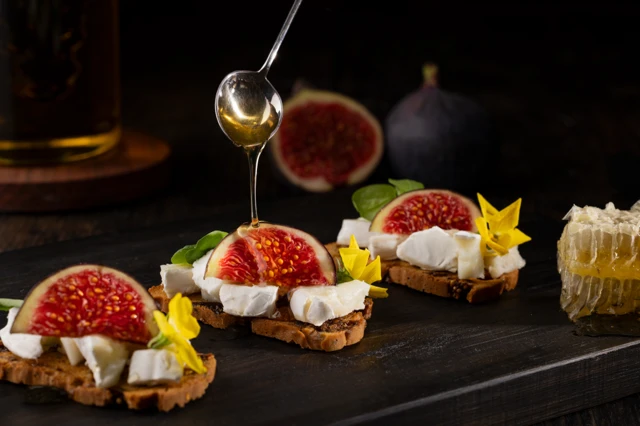Why Food Loves the Light People Hate!

What you’re looking at
Goat’s cheese and fig canapés, finished with honey. Simple ingredients, but the way they’re lit makes them feel indulgent.
This week’s shot is about combining hard and soft light to bring out texture and shine in food. A technique that works very differently here than it would in portrait photography.
Lighting setup
- Soft light: Large diffused source to wrap the cheese and soften shadows, keeping it appetising
- Hard light: Narrow-beam source from camera right, angled low to create sparkle on the figs, gloss on the honey and plenty of texture
- Balance between the two ensured the food looked fresh and dimensional — well lit to be visible, but not over-lit to kill the mood
Camera settings
- Shutter: 1/200
- Aperture: f/11
- ISO: 100
- Lens: 100mm macro
- Tripod-mounted for precision
We’ve kept the depth of field narrow here, to throw focus firmly on one canapé and give a classy look. The aperture may seem small for this depth of field — in portraiture you’d expect to use a much wider aperture to blur the background — but a 100mm macro lens this close to the subject gives a very shallow depth of field.
Styling and prep
- The canapés were built to highlight contrast: creamy goat’s cheese, glossy figs, golden honey on delicious Miller's Fig and Sultana Toast from Artisan Biscuits
- Honey was drizzled fresh at the moment of capture, with multiple pours and the camera in burst mode to catch the perfect flow
- A small vintage demitasse spoon was used to match the scale — nothing too clumsy
- Honeycomb at the edge of the frame reinforces flavour and sophistication and adds textural context
- The background was kept moody, adding an autumnal, classy vibe, while still giving context
Editing touches
- Cleaned stray crumbs from the board
- Balanced highlights to keep the honey from being too bright and stealing attention from the canapés
- Subtle dodge and burn to keep texture in the cheese while letting the figs remain the hero
Why this works
In portrait photography, hard light can be unflattering, because every pore and wrinkle shows. In most portraits, that’s not appreciated!
But in food photography, that same crispness creates appetite appeal: glistening honey, juicy figs, and textures you can almost taste. The soft light supports it, keeping the overall feel inviting rather than clinical.
Worth knowing
Food demands different techniques to those you’d use for people.
Lighting setups such as ring lights are designed to remove shadows — but it’s those shadows that bring out texture. No shadows, no texture. So it doesn’t work with food.
Conversely, hard lighting looks harsh and unflattering on a face, but can make food look irresistible.
That’s why a specialist approach matters; the subject is different, and the lighting has to match.
Also…
Want a chance to win a free shoot? Sign up to our newsletter and stay in the draw every month you’re subscribed.
Curious what stronger images could add to your sales? Try our ROI calculator.
Loved this food photography?






